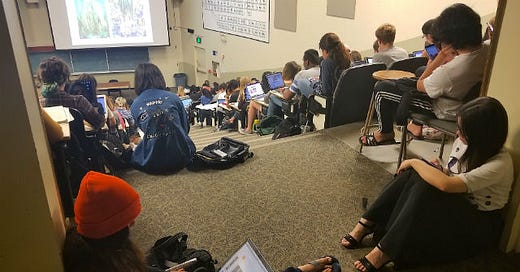Education seems enormously expensive - $13,494 per K-12 student as of 2020 in the U.S. Yet I’ve occasionally heard smart people argue that the true cost of the marginal student is roughly zero.
How is that possible? Take a look at a classroom. It almost always has a spare seat. The building’s already there. The teacher’s already there. What does it cost to just let one more student sit in that seat and learn? Basically nothing, right?
Since I keep inviting the whole world to come to GMU and informally attend my classes, I cannot summarily reject the claim that the true cost of the marginal student is roughly zero. The reason I can casually offer free Caplan lectures to all comers is that neither I nor anyone else has to pay extra to fulfill my offer. Educational resources sit idle. Rather than let them go to waste, why not use them?
But you need not summarily reject this argument to recognize its limits. The marginal cost of welcoming additional students is zero… until the room is full. “We can costlessly switch to another room,” you say? Well, what happens if that room reaches capacity? Eventually, you run out of bigger rooms - or at least bigger rooms that are available for zero added expense.
And when that happens, the marginal cost of adding another student suddenly becomes astronomical!
Suppose you can teach a class of 30 students for $500,000. If you only have 27 students, the marginal cost of student #28 is zero. So is the marginal cost of students #29 and #30. To add student #31, however, you need to start a whole second classroom. Marginal cost? $500,000! Instead of being below the average per-pupil cost of $16,667, it’s 30 times as high.
There is a general principle at work. The naive view of the world is that the cost of every individual equals the average cost. The sophisticated view is that the cost of the typical individual equals zero. The even more sophisticated view, though, is that the cost of the typical individual is either roughly zero - or almost astronomical. Expectationally, the naive view is not far wrong: If the current population of a class is uniformly distributed from 0-30, the expected cost of adding a student is 29/30*$0 + 1/30*Total Cost, which exactly equals Average Cost.
Sometimes, granted, we know the current population of a class. I know that I have plenty of room for guests in my classrooms, therefore I know that the marginal cost is zero. When you’re planning a whole school system, in contrast, you have to guess how many students you’re going to have, so you should use the expected cost. Which is our old friend Average Cost.
Once you take this insight seriously, don’t all arguments (including pro-immigration arguments) based on non-rivalry vanish in a puff of smoke? No, because sometimes the marginal cost of a good remains zero over an enormous range. Ideas, most notably, are the quintessential non-rival good - and the marginal cost of letting one more person use an idea remains roughly zero all the way to infinity. Non-rivalry is real. It’s just not a real as it looks.





It seems we are leaving out some things.
1. Grading homework and tests is a cost for the teacher
2. Textbooks which are provided for free in K-12
3. Disruption of other kids learning. Some of those extra kids will be disruptive, causing learning loss.
You seem to be treating this like a university lecture hall, and one in which the professor doesn't have 1 on 1 office hours or need to do grading.
But most learning, especially K-12 learning, requires labor intensive supervision by teachers. At a minimum they have to keep the kids under control. At the higher end students may need one on one instruction from time to time.
And so something like school vouchers, which took kids out of the public classroom, may or may not increase effective per student funding and on different timelines. The school can lay off teachers if it sees sustained lower enrollment (in theory, ignoring politics) or freeze new hiring. And it can slow down new school construction or order fewer of those overflow trailers. It could even shutter or combine schools in the long run.
Obviously, this isn't something that the K-12 system would want to do, but it wouldn't be the end of the world. Talk about "taking money out of the schools" is basically bogus, as eventually the labor and capital investment will correlate to the new enrollment. Teachers that didn't get work in public school could find demand for their services in new private schools (if they are good at their job).
P.S. In the northeast spending per pupil is over $20k, and this often excludes gargantuan pension liabilities. Most increases in government spending have been at the state/local level, often the K-12 school systems. Whenever people tell me we don't have money for giant child tax credits, I remind that all I really need is to re-direct the K-12 budget directly to parents.